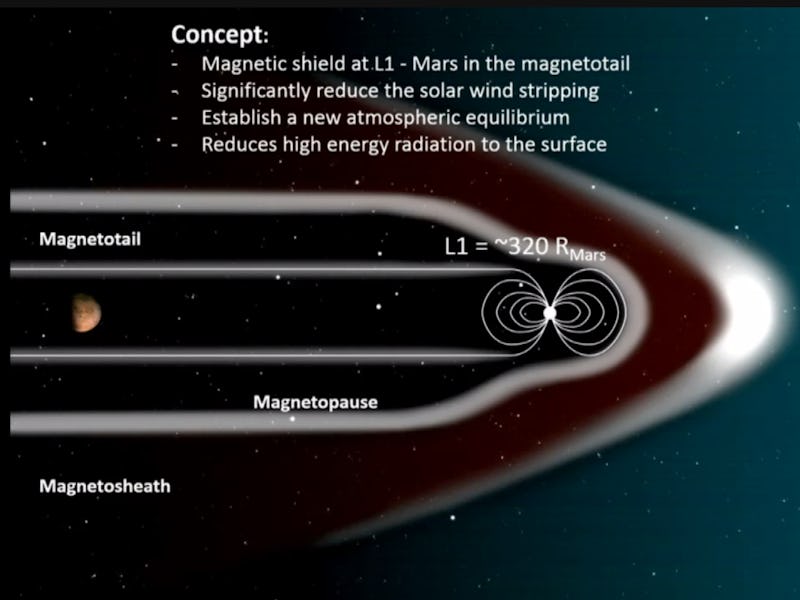The Martian atmosphere is a decimated shred of what it once was, thanks to the fact that a disappearing magnetic field allowed solar winds to pummel the red planet’s skies over millions of years. So naturally, one solution to making Mars more habitable may be to resurrect its magnetosphere — and it’s a crazy idea NASA scientists are actually looking into.
At Wednesday’s Planetary Science Vision 2050 Workshop at the NASA headquarters in Washington, D.C., NASA’s Planetary Science Division Director Jim Green spoke about how this magnetic shield would work.
“It may be feasible that we can get up to these higher field strengths that are necessary to provide that shielding,” Green said. “We need to be able then to also modify that direction of the magnetic field so that it always pushes the solar wind away.”
A planet’s magnetic field is a barrier against solar winds that can do serious damage to the atmosphere. A robust atmosphere that keeps a planet warm enough and pressurized enough to sustain liquid surface water will be stripped away by solar winds in a relatively short time. As the atmosphere goes, so does the water — which is precisely what is thought to have happened to Mars a long time ago.
NASA’s idea involves implementing a magnetic dipole shield consisting to Mars L1, an orbit between Mars and the sun. This shield, which would generate an artificial magnetic field, could reduce solar wind stripping and radiation, as well as restore Mars’s atmosphere, making it more balanced and suitable for humans.
“Perhaps one-seventh of the ancient ocean could return to Mars,” Green said.
In addition, this shield could possibly create an environment to melt the water in Mars’s polar caps. However, the team still needs to do further testing.
About 3.5 billion years ago, Mars had a significant amount of water, and the planet was covered in lakes and running rivers. But after rapid climate change, the planet is now desolate. The planet has extreme temperatures, sometimes reaching as high as 170 degrees Fahrenheit and as low as minus 195 degrees Fahrenheit, as well as pressure waves throughout the day.
Over its history, Mars lost 85 to 90 percent of its atmosphere. Right now, most of its atmosphere is carbon dioxide, while oxygen leaves the atmosphere and is carried away by solar winds.
This chart shows the five most abundant gases in Mars' atmosphere.
The research team conducted atmospheric simulations of Mars to see how the magnetic shield would affect Mars’s climate, including over extreme solar wind events.
They found that increasing the magnetic dipole would stop solar wind stripping. However, increasing the surface pressure doesn’t have a large effect on Mars’s global temperature and it increases dust in the atmosphere. But in some cases, the equator heats up and the polar caps collapse, causing CO2 ice caps grow and stabilizing Mars’ climate.
“This is not terraforming as you may think of it where we actually artificially change the climate but we let nature do it, and we do that based on the physics we know today,” Green said. “This tells us that perhaps we don’t have all the physics in the model we need. We have a little more work in this area.”
To continue with the research, the team plans to continue modeling Mars’s climate to look at radiative effects of ice clouds and trace gases. However, Green believes we can change Mars to have a similar climate to Earth.
“The solar system is ours,” Green said. “Let’s take it. And that of course means Mars, and for humans to be able to explore Mars together with us doing science, we need a better environment.”
